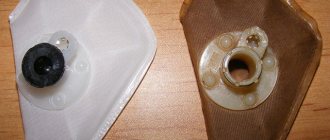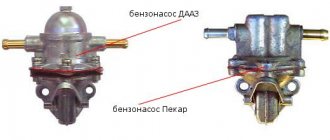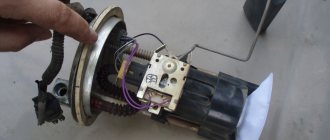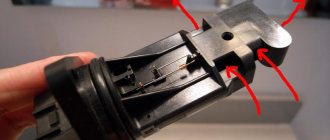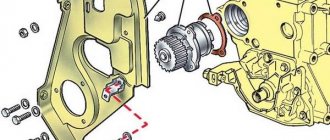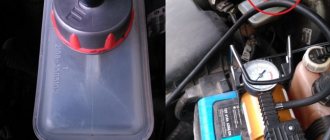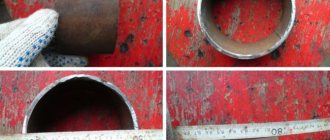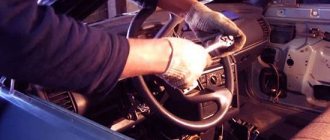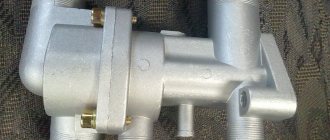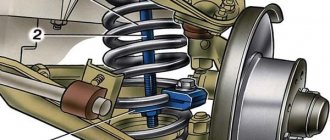Volkswagen Tiguan S&S 170 HP Full › Logbook › Cleaning the fuel pump screen or what we drive
It all started on a beautiful Friday evening in June. Having escaped from the Moscow traffic jams onto the highway, I pressed the gas as usual, the tachometer needle quickly reached 4000 rpm and... bounced back! At the same time, the car jerked, as if I had suddenly hit the brake and released it. After that the car drove off as if nothing had happened. This rather puzzled me. The next day I drove the car in acceleration mode to hundred in 8 seconds - everything was fine. The situation repeated itself on another Friday, again it was hot, again I had been driving for a couple of hours, again there was a sharp acceleration and jolt. It looks something like this. I always pressed on the gas, but you can see how the tachometer needle twitches around 4 thousand and the camera twitches after the car:
In general, this bothered me, but all hands did not reach, as usual. Until I happened to go from Dmitrovskoe Highway to the south of Moscow in September. There wasn't much traffic, but there were a couple of bottlenecks. The tremors began already at 3000 thousand, and after the next narrowing, the car simply stopped accelerating, I drove to the side, stopped and stalled. The car wouldn't start. While I was talking with the service about the tow truck, the car cooled down a little and started up, giving a Check Engine light. I started to drive towards the service, but decided to look at this error first, since the laptop and Vasya are always with me:
008851 - Fuel pressure regulator P2293 - 000 - mechanical fault - Intermittent Freeze frame: Fault status: 00100000 Fault priority: 0 Error frequency: 11 Forgetting index: 255 Mileage: 48319 km Timing: 0 Date: 2028.14.09 Time: 14:17 :04
By the way, does anyone know what date this is?
In the end, I decided that since the problem is not permanent and the car is moving, I will not go to the service center, but will go home. I drove home normally, without acceleration or jolts. Along the way, I took logs (red - fuel pressure requested; green - actual):
It is clearly seen that during acceleration the pressure increases and then drops to zero. It’s as if the fuel injection pump can’t cope. So, the fuel injection pump is fine, it just has nothing to produce, because... it does not receive fuel. Thanks to the forum, I found out that 90% of problems with fuel are caused by the fuel pump mesh.
Remove the rear right seat. To do this, take a 17mm spanner and unscrew the two nuts in the front (under the plugs), move the seat forward and unscrew the bolts at the back:
When to change the fuel pump mesh Lanos, Sense and Chance
Any filter becomes dirty over time, and this also applies to the mesh installed at the inlet of the gas pump. When the element becomes clogged, there is a decrease in its throughput, resulting in a decrease in the amount of intake fuel. Reduced gasoline absorption has a negative effect not only on the fuel pump itself, but also on the functioning of the engine. A clogged mesh of the Lanos suction device leads to the following consequences:
- The load on the pump electric motor increases, causing it to heat up more. This reduces the service life of the device
- The absorption of the amount of fuel decreases, which ultimately leads to a decrease in the quality of cooling of the pump electric motor.
- The pressure in the fuel line decreases, which negatively affects the functioning of the internal combustion engine
The main signs of a clogged fuel pump filter on Lanos are:
- Problem starting the engine due to low pressure in the fuel line
- The engine does not start at all if the filter is heavily clogged
- When the car moves, jerking and jerking appears, indicating problems with the fuel supply
If the above symptoms occur on Lanos, it is necessary to resort to replacing the part. Every driver can cope with this, but the biggest drawback of the process of replacing the fuel pump grid on Lanos is that this will require dismantling the entire module.
This is interesting!
Some drivers prefer to clean it instead of replacing the mesh. This is not a rational approach to such an event, since it is impossible to clean the element to perfect condition. However, this method is suitable when the engine does not start due to a clogged filter mesh, but you still need to get home or to a car service center.
Filter at the inlet of the fuel pump - purpose
It is clear that the main purpose of the filter is to retain various contaminants. The mesh on the Lanos fuel pump (popularly also called a diaper) is a filter element for rough cleaning of fuel. It serves to prevent contaminants from entering the fuel pump.
The absence of a mesh will lead to accelerated failure of the pump. That is why a mesh is installed at the entrance to the gasoline pump to prevent large and medium-sized contaminants from entering the electrical mechanism. After the fuel pump there is another filter, which is designed to clean the gasoline pumped from the tank to the fuel rail. The absence of this filter will lead to accelerated clogging of the injectors and a decrease in their performance.
Replacing the fuel pump mesh for Skoda Octavia
I recommend that all Skoda Octavia owners select the mesh according to the fuel pump number, which is stamped on top of the fuel section. There are several options for collapsible and non-demountable structures. In my case, the filter in the form of a flask beats by number. The Skoda Octavia fuel pump is located in the tank; access to it appears after tilting the right side of the rear row of seats.
1. Replacing the Skoda Octavia A5 fuel pump begins with thoroughly cleaning the fuel section. Otherwise, some of this dust and dirt will end up in the tank. This can be done with a vacuum cleaner and a regular brush.
2. Using small blows into the grooves along the inner edge, unscrew the pressure plate counterclockwise. Place a mark on the fuel module body and tank to facilitate positioning of the section during installation.
3. Pull the section out of the tank so as not to bend the float rod of the fuel level meter. Before starting disassembly, pour all gasoline from the flask.
4. Unscrew the 4 screws securing the coarse mesh housing.
5. Disconnect the motor power terminals. Pull off the fuel pump fuel pipe clamp. In the original, a disposable clamp is installed on the car. In my case, I didn’t have one at hand, so I had to install a regular one during assembly. Before removing the handset, warm it up with a hairdryer.
6. Unclip the 3 plastic clips connecting the cover and the bottom of the fuel section.
Cleaning the fuel pump mesh
As you know, the engine is the most important component of a car. The main element of supplying the working mixture to the engine system is the fuel pump, which is responsible for supplying gasoline to the filter element and subsequently to the combustion site.
The period of operation of engine system elements and the fuel pump, among other things, is influenced to a large extent by the quality of the fuel mixture. In frequent cases, the use of insufficiently purified gasoline leads to dysfunction of the vehicle. If the fuel pump is clogged, the car begins to move jerkily or does not start at all.
The first step in restoring the function of the car, in this case, is replacing the fuel pump grid.
During the operation of the car, the fuel pump mesh becomes quite clogged and its condition can surprise even an experienced car enthusiast.
Selecting a fuel pump strainer for Lanos, Sens and Chance and its features
Before you start replacing the fuel pump strainer on Lanos, Sense and Chance, you must first purchase the part. Meshes for fuel pumps for Lanos are produced by different manufacturers. Before deciding on the manufacturer, you need to find out what diameter of the filter element you need to buy. Fuel pump screens for Lanos are available in different diameters: 11 mm and 22 mm. How they differ, and how to understand what diameter filter element to buy for a gas pump, we will find out further.
- New 11 mm mesh - designed for Lanos and Sens cars from 2003
- Old-style mesh 22 mm - for Sens and Lanos cars until 2002
These parameters need to be taken into account, since during the replacement process it may turn out that you bought the mesh of the wrong size, and it will need to be changed. Which manufacturer is the best product to buy? Today, the products in question are produced by the following companies:
- FSO is a Polish manufacturer characterized by the production of reliable and affordable spare parts. Part number for the fuel pump for Lanos is 96350589
- ICRBI is a Chinese manufacturer that produces spare parts of no worse quality than FSO. Part number 13042081
The price of the spare part in question is not so high as to save on it and sacrifice the quality of the engine. As a result, it should be noted that the procedure for replacing the mesh takes a little time, and most importantly, you can do it yourself.
Instructions for replacing the fuel pump mesh on Chevrolet, ZAZ and Daewoo Lanos, Sens and Chance
It should be noted right away that the resource of this filter element ranges from 50 to 100 thousand kilometers. It all depends on the quality of the gasoline being poured into the tank, but you can refuel once unsuccessfully and, at best, end up having to replace the filter, and in the worst case, you will have to change the fuel pump.
Next, we’ll look at how to replace the Lanos fuel pump mesh yourself, and what you’ll need for this. When carrying out the work, you will need a minimum set of tools, consisting of a flat or slotted screwdriver, steel wire and a hair dryer. To replace the mesh, you will need to remove the entire fuel pump module. How to do this yourself is described in detail in the material on removing the gas tank or instructions for replacing the Lanos fuel pump. The process of dismantling the fuel pump assembly with the mesh must begin by disconnecting the negative terminal of the battery.
https://youtube.com/watch?v=fXUnZuodjlU%3F
After the fuel pump module assembly is removed from the mounting hole of the tank, we proceed to further steps to replace the strainer:
After removing the pump, there will be some fuel left in it, which can be poured back into the tank or container by turning it down with its upper part. We place the entire mechanism assembly on a clean cloth or newspaper, and proceed to replacing the mesh. First of all, you need to dismantle the float, for which you remove the plastic C-shaped clip. To remove the clip, you need to compress it and remove it from its seat. To get to the fuel pump coarse filter, you need to remove the top cover of the plastic flask. It is attached using three protruding slots, which need to be pressed with a screwdriver. Before removing the top cover of the flask, you need to disconnect the power supply connector for the fuel level sensor. This sensor is attached to the outer flask (it is also called a glass). Next, we proceed to dismantling the inner flask with the fuel pump, since the mesh is attached specifically to it. You can dismantle the inner flask using strong steel wire, from which you need to make a hook. An example of such a hook is shown in the photo below. The hook is needed to dismantle the inner flask (with the fuel pump), to which the mesh is attached. This flask is fixed using an internal protrusion along the circumference on the outer flask. The photo below shows a protrusion in the inner part of the outer flask, through which the fuel pump bracket with filter is fixed. To simplify the process of dismantling the inner flask, you need to heat the walls of the outer bowl with a hair dryer
This will lead to its expansion, which will allow you to easily and quickly remove the flask (it is important not to overdo it with a hairdryer). Using a hook, you need to grab onto the plastic protrusion on the inner flask and pull towards you (moderately). To increase the effectiveness of actions, efforts should be made alternately at several points
As a result, the inner flask with the gas pump and the mesh located in the lower part is removed. It is this mesh that will have to be replaced, having previously assessed its condition. In 100% of cases, the inside of the outer flask will have contaminants that should be removed. We proceed to removing the mesh, for which the first step is to remove the retaining ring (washer) by prying it off with a screwdriver. Remove the old filter, replace it with a new one, and secure it with the retaining ring. It is recommended to purchase a new ring, since when it is removed, the quality of fixation has significantly decreased. If you install the old ring, then there is a high probability that the mesh may come loose during operation. We install the Lanos gas tank mesh in place and carry out the assembly in the reverse order.
The procedure for replacing the gas tank mesh is not difficult, but it is very responsible, since the work is carried out with parts that are coated with highly flammable substances.
After assembling and installing the fuel pump with the new element in place, you can put the negative terminal on the battery and turn on the ignition. When the pump pumps gasoline and turns off, you can start the engine. This completes the process of replacing the fuel pump mesh.
This is interesting! Two types of fuel pump modules TA and TG were installed on Lanos. The principle of replacing the mesh on TG type devices is discussed above. Blocks of the TA type differ in that the mesh on them is located on the outside. You can read more about the differences between the modules.
https://youtube.com/watch?v=KIs_mGTSxUA%3F
How to clean dirt from the fuel pump screen?
You will need:
#1
In some car models, the gas tank is located under the passenger seat. To work, you need to prepare the following tools: carburetor cleaner, gloves, wrenches, screwdrivers, a flashlight, a pump (electric or mechanical) that will be powered by another machine, a marker, WD40 in case the bolts and nuts stick, and a fire extinguisher. You should remove the fuel pump fuse and start the car engine (it will stall after a couple of seconds) before cleaning the fuel pump screen. This is done to prevent gasoline from spilling into the passenger compartment. It's better to play it safe and leave the tank half empty. After releasing the pressure, you can remove the battery terminals. Between the rear seats, or more precisely, under them, there is the right gas tank door (hatch).
#2
After unscrewing the bolts, it can be easily removed. From here you can see the fuel level sensor, to which two power connectors and two hoses are connected. One of them is for the fuel pump. If it is particularly dirty, you can vacuum it. You can learn from specialists how to clean a fuel pump mesh or how to knit a fishing net and solve the problem yourself. After cleaning the devices, connectors and hoses must be removed. The hoses can be marked with a marker; it is better to plug the holes in their place. After unscrewing the bolts, the structure is removed. However, you should be careful not to damage the sensor float, which is located on the side. Now you can see the tank with gasoline inside. It is better to disconnect the power connector going from the fuel pump to the sensor for convenience. You can learn how to tension a chain-link mesh from the article on the corresponding website. You need to put on a rubber glove and put your hand into the gas tank. You need to find the fuel pump, a latch that should be pressed and then pull the fuel pump towards the hood. Sliding along the slide, the fuel pump comes out of the tank. If there is gasoline, it will pour out for a while, so it is better to hold it over the tank. The fuel pump is located inside a plastic shell - it can be easily disassembled into two parts using latches. Sometimes it is necessary to replace the mesh.
#3
You can also learn how to change the mesh on the fuel pump from this article. The small pink bag is the fuel pump filter. Dirt accumulates on the outside of the filter mesh. Sometimes there is so much of it that it is easier to change the grid itself. Replacement is easy and can be done in five minutes. Dirt should be removed using carburetor cleaner. Assembly is carried out in reverse order. Sometimes it is difficult to place the fuel pump back into the tank and place it on the skid at the very bottom. You can learn how the mosquito net is attached and how to change the net on the gas pump by wisely using the information search system on the World Wide Web. Care must be taken to carry out the entire process from start to assembly. If you follow the instructions and sequence of actions, the car begins to work much better: acceleration is optimized, noise disappears. If the problems cannot be resolved on your own, it is better to contact a specialist. Perhaps the reason is something else.
uznay-kak.ru
Assembly
The fuel pump must be installed so that its outlet fitting coincides with the recess in the top cover. Therefore, first, disconnect the insert with a coarse mesh from the flask (held on by several small latches).
Install the fuel pump into the flask, not forgetting about the sealing ring in the grooves of the lower and upper parts. A small ring is put on the body of the gas receiver. Snap the mesh onto the flask, aligning the fuel return drain fitting with the fitting on the mesh body.
Secure the plastic cover with 3 clips, put on the fuel pump hose, connect the power wires and screw on the part of the housing with the fuel level meter. The remaining components of the system are assembled in the reverse order of removal and do not cause any difficulties.
Do-it-yourself fuel pump screen cleaning.
To carry out the work, you need to stock up on the following materials:
- Compressor.
- Fuel pump gasket.
- Nozzle seal.
In order to clean the hard filter, it is necessary to dismantle the fuel pump.
- Turn off the car's power source.
- Unscrew the holders and remove the cover.
- We remove the electric drive.
- We disconnect the fitting and the conductor through which the fuel circulates.
- We also remove the fitting and remove the fuel outlet hose.
- Remove the seal.
- Raise the gasoline compressor and remove the float. Next, together with the mixture level analyzer, we dismantle the fuel pump.
- At the bottom of the pump there is a mesh (coarse filter).
It is quite difficult to determine the contamination of the mesh by visual inspection. Small particles can interfere with the proper functioning of the fuel, while remaining almost unnoticeable. To successfully wash the mesh, you need to let it soak in a special solution. To do this, you need to dilute the detergent one to ten with water. Next, you need to place the mesh in a tank with the prepared composition and leave it there for one hour.
After this, you can proceed to the main cleaning stage.
- To do this, uses the same composition and a brush with fine bristles. Using the specified materials, thoroughly rinse the mesh.
- After this, you need to clean the filter with a stream of air. To do this, we use a compressor.
- Next, you need to wait until the filter is completely dry. After which, you can assemble the fuel pump.
After washing the element, it is necessary to carry out repeated visual diagnostics. The network must not have mechanical damage. Otherwise, further use of the element is impossible and the filter must be replaced.
After completing all stages of work, we assemble the fuel pump in the opposite order. Next, you need to check the correct operation of the fuel system and the success of the operation.
https://youtube.com/watch?v=xnKwDtCtM_0%3F
During the operation of the car, it is necessary to promptly pay attention to malfunctions in the fuel system and regularly replace used filters. Happy renovation!
Happy renovation!
Fuel filter cleaning steps
If you decide to clean the fuel filter yourself and the dismountable filter, follow the following step-by-step instructions.
- To find the fuel filter, you need to look at the fuel line from the carburetor or fuel injector. This is usually a small plastic or metal part.
On carburetor VAZ models, the fine fuel filter looks like shown in the photo - If the fuel line extends away from the engine towards the fuel tank, you may have an electric fuel pump. It is often placed in the back of the car or submerged in the gas tank. Be sure to disconnect the battery before overhauling the electric pump, because an accidental spark can ignite gasoline vapors.
- If you have a mechanical pump, use a flat-head screwdriver to clamp the hose and plug the fuel line on both sides of the fuel filter. The fuel in the fuel line may be under high pressure. Therefore, it is better to wear safety glasses to protect against vapor spray.
- Next you need to disconnect the hose clamps. When the clamps are loosened, you need to pull out the hose from the fuel filter and drain the excess fuel into a container. When the filter is empty, remove any remaining fuel using a dry, lint-free cloth.
Unscrew the clamps and remove the fine filter for washing - Wash the fuel filter on both sides with kerosene, solvent or acetone and knock off any remaining debris on any hard surface. It also doesn't hurt to blow out the fuel filter with a tire pump.
- Repeat the process until the fuel filter is in acceptable condition.
- Make sure the gaskets are in good condition. Replace them if necessary.
- After cleaning the fuel filter, let it dry and then reinstall it. If the filter is damaged, has perforations or cracks, you better replace it.
How to wash the fuel pump mesh
It so happened that when driving for a long time on the highway in pouring rain, the car stopped moving. The traction disappeared. I stopped for 10 minutes, started it and drove again for a while, then the same situation - the engine twitches and doesn’t want to go. I came home late at night, parked it until the morning, I thought that in the morning the car would be better (it was like that before a couple of times, but then it went away on its own), but in the morning the car barely started and did not want to drive normally. I had to gather a consultation of auto-minds and analyze the situation. VAG-COM did not clearly clarify the situation, there were no errors. We came to the conclusion that we need to climb into the tank and look at the fuel pump. The operation is not entirely simple! To get to the fuel pump in AVNT (and it is located in the trunk closer to the rear seat ) required:1. remove the rear seat2. remove the rear seat backrests3. remove the trunk floor lining at the 5th door (trunk)4. Remove the left and right trunk trims5. remove the plastic trunk trough (it forms, as it were, a double floor) and after that you have access to the hatch, which is screwed to the floor, under which there is a submersible fuel pump. I took all this apart and saw the body of the fuel pump, which is screwed to the tank with a huge plastic nut, to unscrew this nut, a special tool is usually used (there is such a puller), but we unscrewed it using a huge flat screwdriver and a hammer, gently tapping in the direction of unscrewing (counterclockwise) on the end ribs of the nut. Next, there is one point! You need to bleed pressure in the fuel supply system, otherwise if you remove the hose under pressure, everything will end up in gasoline! Tested by personal experience! )))) This is easy to do: remove the chip from the fuel pump, start the engine and wait until the car stalls (after that I recommend looking at and resetting engine errors).
Next, you need to use some skill to remove the fuel pump complete with housing from the hole, because The fuel level float sticks out from the body to the side, and the hole is round along the diameter of the pump.
After I removed the fuel pump from the depths of the gas tank, I immediately looked into the gas tank with a flashlight - the bottom was clean. This means we need to look at the fuel pump. There was a suspicion that the pump itself was dying. Disassembling the fuel pump housing was not very difficult, I unfastened several plastic hooks and the housing was disassembled into 2 parts (naturally, I first removed the float). I pulled the pump itself out of the housing and found that in the lower part of the housing (the housing is not dismountable) there is a mesh that filters the gasoline entering the pump from the tank, it is all black, as if in used oil. As they later explained to me, the black oily fraction is silt that forms in the upper part of the tanks when storing gasoline, because condensation + heat forms there — that’s where life comes from))). In the end, realizing that there was no way to remove the mesh in order to wash it, I resorted to military stratagem and asked my friends (after all, the car was standing on the street, all disassembled and with a hole in the gas tank approximately 100 mm in diameter, I didn’t decided to close it and leave it, but stood and ventilated it all this time) drive to the nearest car wash and ask the washers to wash the mesh with foam for washing the body and then rinse everything there with plenty of tap water. After 10-15 minutes they brought it clean, like a new pump housing and I started reassembling it. I assembled everything and the car drove after this operation as before.
To find out what condition the fuel system is in, you need to check its performance. To do this, you need to connect a measuring device to the gasoline supply system. In order to connect the pressure gauge to the fuel system, you must use a special device. Therefore, in this case you will have to contact a specialized workshop. For self-checking, you can use the following:
- Turn on the ignition. If the fuel pump does not work or makes abnormal noise, the gasoline supply unit may be overloaded.
- If engine performance decreases, the acceleration period increases, or the engine idles improperly, excessive clogging of the fuel lines may be the cause.
As a rule, a clogged fuel filter leads to such consequences.
In this case, the filter requires mandatory replacement, and the mesh can be cleaned with your own hands. In most cases, cleaning the mesh will give the desired result for a while. However, the price of the part is not that high, and it can be replaced without resorting to the help of workshops.
The replacement process will not take much money and time, but will nevertheless increase the service life of the fuel pump and other elements of the system.
How to clean the fuel pump yourself
Let's start with the fact that the mesh filter for the fuel pump is a coarse filter and is designed to capture large particles and deposits that are in the fuel and inevitably accumulate in the fuel tank. It turns out that the fuel pump has its own additional fuel filter mesh, which prevents debris from entering the fuel system from the tank parallel to the usual fuel filter. The process of cleaning or replacing the fuel pump mesh is almost similar to the general scheme for replacing the pump itself:
- The fuel pump is installed directly into the gas tank. You can get to the pump from the passenger compartment, as it is located under the rear seat. To gain access to the fuel pump, you need to remove the rear seat cushion or fold down half of the sofa (if possible).
- The fuel pump is usually located on the right and covered with a special plastic cover. The specified cover must be removed.
- Before removing the fuel pump itself, it is necessary to relieve the fuel pressure in the system. To do this, you will need to disconnect the power connector from the fuel pump, and then turn the engine with the starter.
- The next step is to remove the negative terminal from the battery, after which the tubes from the fuel pump are disconnected.
These tubes are “supply” and “return”, they are secured with clamps that need to be pressed out. You should be prepared for the fact that a certain amount of gasoline may spill after removal. For this reason, safety precautions must be observed! - Next, you need to unscrew the special pressure ring-cover of the fuel pump. It is very difficult to unscrew this cover manually. There is a special fuel pump cover puller for removal. If there is no such puller, then you can try to carefully unscrew the ring using improvised means. We strongly recommend that you first study on specialized auto forums how to remove the fuel pump cap on a specific car model.
- After unscrewing the cap, you can remove the fuel pump. Before complete removal, the remaining gasoline should be drained from its body, and the sealing ring should be removed.
- Now you can begin disassembling the fuel pump housing. To clean, you will need to remove the bottom part. There is often dirt in the indicated lower part of the housing.
- After this, remove the fuel pump screen. To remove the mesh, just pry out the filter at the place of attachment to the pump body using a regular screwdriver. The fuel pump strainer usually becomes completely clogged, especially on cars with high mileage.
- Then the fuel pump mesh can be replaced with a new one or cleaned. It is better to wash the fuel pump mesh first with carburetor cleaner. Mechanical cleaning is done with a soft brush. Then the mesh should be dried and blown. The bottom of the pump housing and the cleaned mesh are finally washed again with gasoline.
- The final step is to reassemble the fuel pump and install the device in the gas tank. To facilitate installation, it is better to invite an assistant, as it may be necessary to ensure high-quality pressure of the pump to the tank. The fact is that many gasoline pumps have a special spring, the force of which must be overcome. At the same time, you need to make sure that the rubber seal is in place and at the same time screw in the pressure ring-cover of the fuel pump. When tightening the clamping ring with a puller or improvised means, do not exceed the tightening torque. If you tighten it too tightly, the fuel pump cap may burst; if you tighten it too weakly, the fuel pump will wobble due to poor fixation.
Please note that when installing a fuel pump on many car models, you must be careful not to bend the fuel level sensor in the gas tank. It is also important to adhere to the position in which the pump was originally located.
In order to determine the correct position of the fuel pump, there are special indicators. Such indicators are made in the form of arrows and are located on the fuel pump, the gas tank body and the pressure ring. The correct installation of the fuel pump can be considered when all the arrows are in the same line. We would like to add that if the gasket is installed incorrectly, gasoline may leak out if you fill the tank full.
Now all that remains is to connect the fuel supply and return pipes to the fuel pump, while simultaneously checking that the clamps are securely fastened. The completion is to connect the electrical power connector to the fuel pump, after which you can start the car for testing.
Fault diagnosis
There are several signs that indicate that the fuel pump is clogged. Each of them individually may not indicate this one hundred percent, but taken together they are sufficient grounds to begin cleaning. These are the signs:
- the engine stalls when you press the accelerator;
- the acceleration dynamics of the car decreases;
- the engine responds poorly;
- starting with the starter is somewhat difficult;
- When the gas pedal is pressed sharply, jerking occurs.
Depending on how badly the fuel pump is clogged, these problems can vary greatly in scope. For example, if the pollution is very high, then when you press the gas pedal, the car may hardly accelerate.
Cleaning the fuel pump screen can solve these problems, but it is important to remember that there are other reasons that can cause them:
- The injector has failed.
- The fuel pump is not working correctly.
- The fuel filter is dirty.
If the filter and mesh are still easy to change on your own, then for the rest it would be better for a beginner to contact a car service center. This will allow you to avoid gross mistakes that an inexperienced car enthusiast may make during the repair process.
Signs of a clogged fuel filter
It starts poorly, fails when you press the gas pedal, the speed fluctuates, the engine loses power and dynamics - these are the main signs of a clogged fuel filter.
When the engine is running, a fuel-air mixture with the correct proportion of fuel to air must be supplied to its combustion chambers. When the fuel filter is clogged, the fuel supply is disrupted, as a result of which the mixture becomes lean, the engine loses power, begins to stall, and sometimes does not start at all. This is especially noticeable under loads, for example when climbing uphill. It should be added that the loss of dynamics and the appearance of symptoms of a clogged mesh occurs gradually.
When and why you need to change/clean the fuel pump screen
Let's start with the fact that general problems with the fuel system (fuel pump in particular) should be divided into the most common groups:
- the fuel pump mesh and fuel filter are clogged;
- the fuel pump itself has failed;
- injector problems;
Let us add that we should also not exclude the possibility of air leaks, that is, airing of the power system. Another culprit of problems may be the pressure regulator in the fuel rail. In this case, engine malfunctions may be partially similar to some of the symptoms mentioned above. For example, a slight ingress of air into the fuel system results in the engine not starting for a long time after parking.
Let's go back to the fuel pump. Its malfunction means that the performance of the fuel supply system is reduced. If the fuel pump breaks down, then the car becomes unsuitable for normal use. Signs of a fuel pump malfunction are as follows:
- It is impossible to start the engine, the fuel pump does not pump;
- the engine starts, but runs with serious interruptions;
In this case, the service often recommends diagnosing, repairing or replacing the fuel pump. It should also be taken into account that the fuel pump mesh filter may become clogged inside the device. Let us immediately note that it is impossible to accurately answer the question of when to clean the fuel pump stack. Some car enthusiasts clean/replace the fuel pump mesh as needed or as a preventative measure every 50-70 thousand km. mileage, while others are faced with the need to clean the fuel pump grid for the first time at mileages of 150 thousand km or more. and more. Let us add that the operating manual for some models specifically states that it is recommended to replace the fuel pump stack once every 120 thousand km.
It should be added that the loss of dynamics and the appearance of symptoms of a clogged mesh occurs gradually. For this reason, each driver decides to clean the fuel pump himself. On powerful naturally aspirated engines, the gradual deterioration in acceleration is not felt as strongly as compared to highly accelerated engines with a small displacement. For this reason, many owners of large-volume trucks begin to solve the problem after noticeable complications appear. Also, the condition of the pump grid is greatly influenced by the quality of the fuel being filled and a number of other factors and individual operating conditions, which we will talk about a little later.
Cleaning the fuel pump mesh yourself
Cleaning the fuel pump is a fairly urgent procedure that must be carried out when the following symptoms appear:
- Difficulty starting the engine with the starter;
- reduction in vehicle acceleration dynamics;
- jerking when pressing the gas pedal sharply;
- floating speed and sluggish engine response;
- the engine stalls in transition modes after pressing the accelerator, etc.
In some cases, when you press the gas, the car practically does not accelerate, overcomes inclines with great difficulty, and does not overtake. There may be several reasons for such a malfunction, but often the problem is localized in the fuel pump area. Next, we will consider issues related to the electric fuel pump, which is installed in the gas tank of injection cars.
We also recommend reading the article on checking the fuel pump. From this article you will learn how to diagnose the fuel pump of gasoline cars yourself based on the pressure in the fuel rail.
When and why you need to change/clean the fuel pump screen
Let's start with the fact that general problems with the fuel system (fuel pump in particular) should be divided into the most common groups:
- the fuel pump mesh and fuel filter are clogged;
- the fuel pump itself has failed;
- injector problems;
Let us add that we should also not exclude the possibility of air leaks, that is, airing of the power system. Another culprit of problems may be the pressure regulator in the fuel rail. In this case, engine malfunctions may be partially similar to some of the symptoms mentioned above. For example, a slight ingress of air into the fuel system results in the engine not starting for a long time after parking.
Let's go back to the fuel pump. Its malfunction means that the performance of the fuel supply system is reduced. If the fuel pump breaks down, then the car becomes unsuitable for normal use. Signs of a fuel pump malfunction are as follows:
- It is impossible to start the engine, the fuel pump does not pump;
- the engine starts, but runs with serious interruptions;
In this case, the service often recommends diagnosing, repairing or replacing the fuel pump. It should also be taken into account that the fuel pump mesh filter may become clogged inside the device. Let us immediately note that it is impossible to accurately answer the question of when to clean the fuel pump stack. Some car enthusiasts clean/replace the fuel pump mesh as needed or as a preventative measure every 50-70 thousand km. mileage, while others are faced with the need to clean the fuel pump grid for the first time at mileages of 150 thousand km or more. and more. Let us add that the operating manual for some models specifically states that it is recommended to replace the fuel pump stack once every 120 thousand km.
It should be added that the loss of dynamics and the appearance of symptoms of a clogged mesh occurs gradually. For this reason, each driver decides to clean the fuel pump himself. On powerful naturally aspirated engines, the gradual deterioration in acceleration is not felt as strongly as compared to highly accelerated engines with a small displacement. For this reason, many owners of large-volume trucks begin to solve the problem after noticeable complications appear. Also, the condition of the pump grid is greatly influenced by the quality of the fuel being filled and a number of other factors and individual operating conditions, which we will talk about a little later.
How to clean the fuel pump yourself
Let's start with the fact that the mesh filter for the fuel pump is a coarse filter and is designed to capture large particles and deposits that are in the fuel and inevitably accumulate in the fuel tank. It turns out that the fuel pump has its own additional fuel filter mesh, which prevents debris from entering the fuel system from the tank parallel to the usual fuel filter. The process of cleaning or replacing the fuel pump mesh is almost similar to the general scheme for replacing the pump itself:
- The fuel pump is installed directly into the gas tank. You can get to the pump from the passenger compartment, as it is located under the rear seat. To gain access to the fuel pump, you need to remove the rear seat cushion or fold down half of the sofa (if possible).
- The fuel pump is usually located on the right and covered with a special plastic cover. The specified cover must be removed.
- Before removing the fuel pump itself, it is necessary to relieve the fuel pressure in the system. To do this, you will need to disconnect the power connector from the fuel pump, and then turn the engine with the starter.
- The next step is to remove the negative terminal from the battery, after which the tubes from the fuel pump are disconnected.
These tubes are “supply” and “return”, they are secured with clamps that need to be pressed out. You should be prepared for the fact that a certain amount of gasoline may spill after removal. For this reason, safety precautions must be observed! - Next, you need to unscrew the special pressure ring-cover of the fuel pump. It is very difficult to unscrew this cover manually. There is a special fuel pump cover puller for removal. If there is no such puller, then you can try to carefully unscrew the ring using improvised means. We strongly recommend that you first study on specialized auto forums how to remove the fuel pump cap on a specific car model.
- After unscrewing the cap, you can remove the fuel pump. Before complete removal, the remaining gasoline should be drained from its body, and the sealing ring should be removed.
- Now you can begin disassembling the fuel pump housing. To clean, you will need to remove the bottom part. There is often dirt in the indicated lower part of the housing.
- After this, remove the fuel pump screen. To remove the mesh, just pry out the filter at the place of attachment to the pump body using a regular screwdriver. The fuel pump strainer usually becomes completely clogged, especially on cars with high mileage.
- Then the fuel pump mesh can be replaced with a new one or cleaned. It is better to wash the fuel pump mesh first with carburetor cleaner. Mechanical cleaning is done with a soft brush. Then the mesh should be dried and blown. The bottom of the pump housing and the cleaned mesh are finally washed again with gasoline.
- The final step is to reassemble the fuel pump and install the device in the gas tank. To facilitate installation, it is better to invite an assistant, as it may be necessary to ensure high-quality pressure of the pump to the tank. The fact is that many gasoline pumps have a special spring, the force of which must be overcome. At the same time, you need to make sure that the rubber seal is in place and at the same time screw in the pressure ring-cover of the fuel pump. When tightening the clamping ring with a puller or improvised means, do not exceed the tightening torque. If you tighten it too tightly, the fuel pump cap may burst; if you tighten it too weakly, the fuel pump will wobble due to poor fixation.
Please note that when installing a fuel pump on many car models, you must be careful not to bend the fuel level sensor in the gas tank. It is also important to adhere to the position in which the pump was originally located.
In order to determine the correct position of the fuel pump, there are special indicators. Such indicators are made in the form of arrows and are located on the fuel pump, the gas tank body and the pressure ring. The correct installation of the fuel pump can be considered when all the arrows are in the same line. We would like to add that if the gasket is installed incorrectly, gasoline may leak out if you fill the tank full.
Now all that remains is to connect the fuel supply and return pipes to the fuel pump, while simultaneously checking that the clamps are securely fastened. The completion is to connect the electrical power connector to the fuel pump, after which you can start the car for testing.
Tips and tricks
In the case when the gas tank is heavily contaminated, cleaning or replacing the fuel pump mesh will only be a temporary measure, and the rate of subsequent contamination of the mesh will not greatly depend on the quality of the fuel being filled. In such a situation, it is necessary to remove and wash not only the mesh, but also the gas tank.
Remember, cleaning the fuel pump mesh or replacing the pump itself in the fuel tank is a responsible procedure that involves working with fuel equipment and flammable fuel. Follow safety precautions! If you have not previously removed the fuel pump yourself, do not have sufficient experience and are not confident in your abilities, then it is better to turn to specialists.
To keep the fuel pump screen clean, try not to lower the fuel level in the gas tank below ½ unless necessary. Dirt and deposits that clog the mesh are usually located at the very bottom and are the last to be drawn in by the gas pump.
krutimotor.ru
User Experience
My engine rarely stalls. A couple of times there were simply problems with the fuel, but once there was a problem with the pump. I figured out how to take it apart myself. I realized that there was no damage, it was just pollution. I had to change the grille - before I had no idea that they could be cleaned. Since then I have driven a hundred thousand kilometers and so far everything is fine. When another 20-30 thousand are added, then I’ll look under the hood. This time only for preventive purposes.
I'm new to driving, but have already encountered this procedure. When the car didn't want to start the first time, I thought the problem was with the battery. But then the engine began to behave strangely - it either would not start or suddenly increased speed. Friends suggested that we need to disassemble and clean the pump. As it turns out, it's not difficult at all.
Grigory Vasiliev
I became a motorist five years ago. Since then, I have never needed to repair or change anything - my husband usually does this. He simply cleans the grille for himself, but always installs a new one for me. The answer to my questions is that it is safer.
Alexandra Safroshkina
I clean the grille every 150 thousand kilometers traveled. I have a sedan made by Nissan, and I almost never drive it outside the city. Although there are no particular problems, I should do this after about a hundred kilometers. Focus on the ignition - if everything is fine with the battery, then the pump is probably dirty.
Victor Kuznetsov
I never do this myself and I don’t recommend it. Any car service center will do this procedure almost free of charge. In addition, mechanics spend less than half an hour on it, and when you do it yourself, you don’t know exactly how much more digging you’ll have to do.
Aleksey Ivanov
